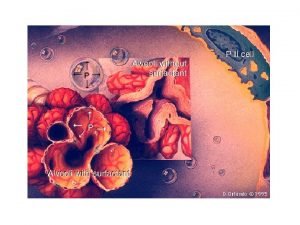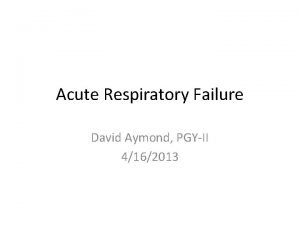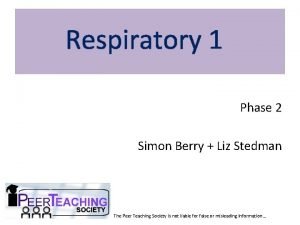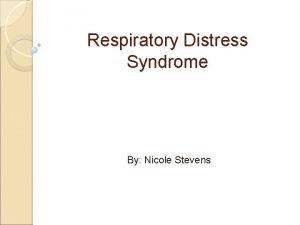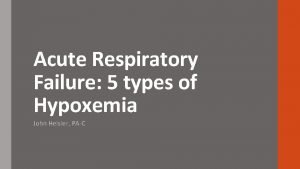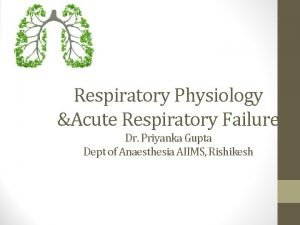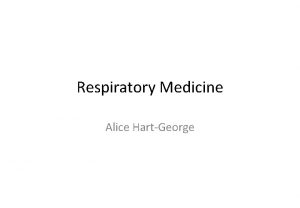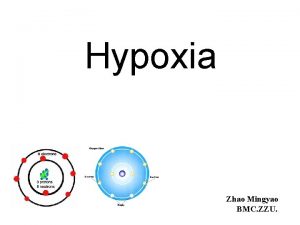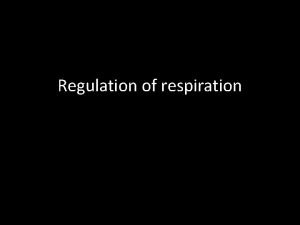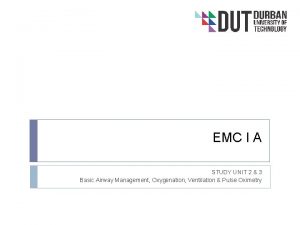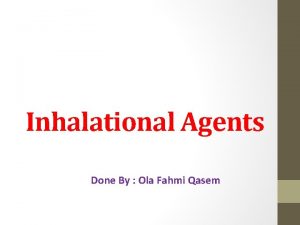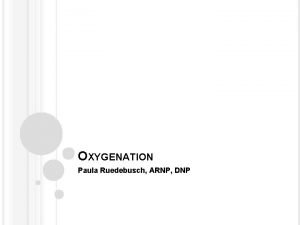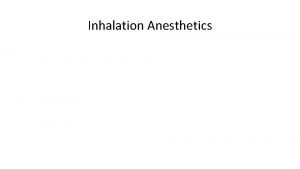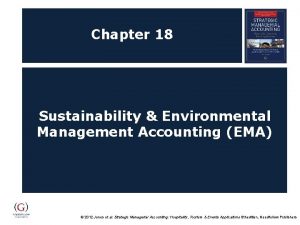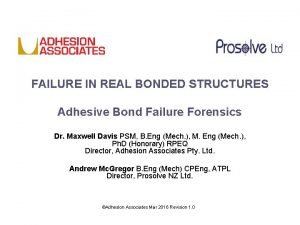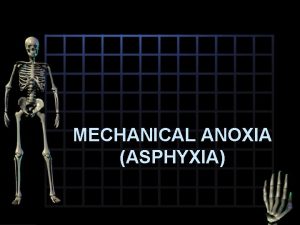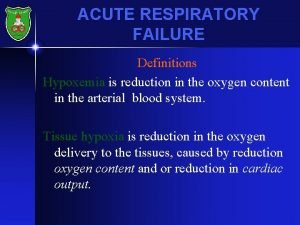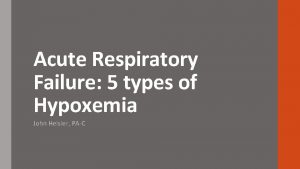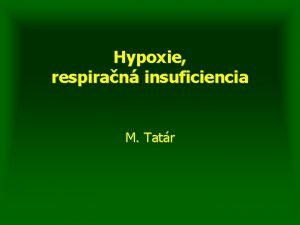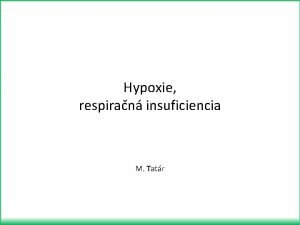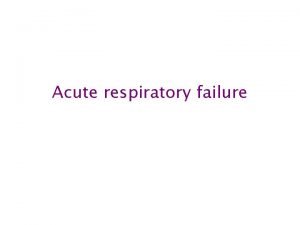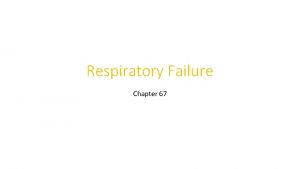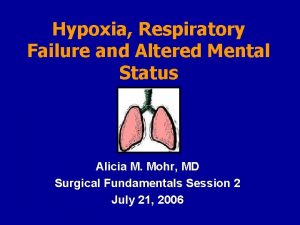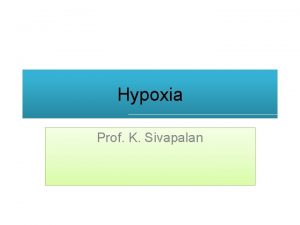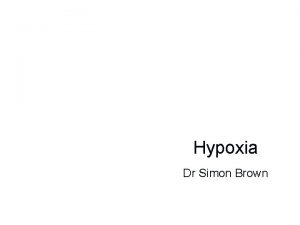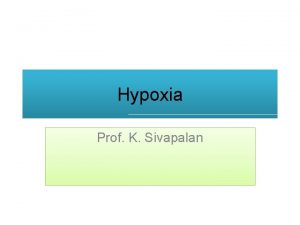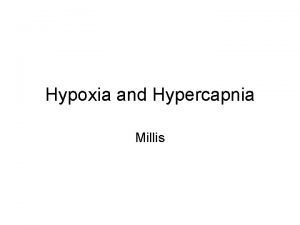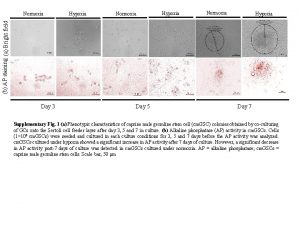HYPOXIA RESPIRATORY FAILURE M Tatar HYPOXIA hypoxemia anoxia






















- Slides: 22

HYPOXIA RESPIRATORY FAILURE M. Tatar

HYPOXIA hypoxemia anoxia ischemia

glucose 38 ATP Krebs´s cycle O 2 CO 2 H 2 O glucose 2 ATP lactate pyruvate

The aim of oxygen transport to preserve high PO 2 gradient between capillaries and mitochondria microcirculation Hb afinity to O 2 respiration erythropoiesis circulation Q x Hb conc. x (Sa. O 2 – Sv. O 2) O 2 c m ADP V O 2

Classification of hypoxia (1) 1. Hypotonic hypoxemic hypoxia - Pa. O 2, Ca. O 2; Q. Hb. ( Sa. O 2 – Sv. O 2) - carotid body stimulation, hyperventilation - pulmonary hypertension in chronic form - respiratory failure 2. Izotonic hypoxemic hypoxia - normal Pa. O 2, Ca. O 2; Q. Hb. ( Sa. O 2 – Sv. O 2) - chemoreceptors are not stimulated, lack of dyspnea - anemia, carboxyhemoglobin

Hb concentration and Ca. O 2 interrelationship 300 100 polycythemia Hb = 20 100 normal Hb = 15 150 anemia Hb = 10 20 60 Pa. O 2 (mm. Hg) 100 120 100 Sa. O 2 (%) Ca. O 2 (ml/l) 200

Classification of hypoxia (2) 3. Hypoextractive hypoxia - increased Hb afinity to O 2 - Q. Hb. (Sa. O 2 – Sv. O 2) released O 2 Sa. O 2 (%) 100 50 p. H = 7, 4; t = 37 °C p. H 7, 4; t 37 °C 6 Pa. O 2 (k. Pa) 14

Classification of hypoxia (3) 4. Hypocirculatory hypoxia - Q. Hb. (Sa. O 2 – Sv. O 2) - ischemic, congestive; local, general 5. Overutilization hypoxia - demand of tissues for O 2 excesses the available supply - angina pectoris, epilepsy (fatigue and cerebral depression) 6. Histotoxic hypoxia - disturbed ATP production, blocked oxidative phosphorylation - Q. Hb. (Sa. O 2 – Sv. O 2) - cyanide

Respiratory failure

Definition Syndrome characterized by disturbed exchange of oxygen and carbon dioxide in lung Consequences: Pa. O 2 60 mm. Hg (8. 0 k. Pa) with or without Pa. CO 2 > 50 mm. Hg (6. 7 k. Pa) - under resting condition - breathing atmospheric air at sea level Classification: 1. Hypoxemic (hypoxemia with normal or Pa. CO 2) 2. Hypercapnic (hypoxemia and hypercapnia)

Factors determining oxygenation and CO 2 exchange are different Pa. CO 2 must be regarded as a function of ventilation of the entire lung (overall alveolar ventilation), without regard to local inequalities of distribution of ventilation and perfusion Pa. O 2, on the other hand, depends not only on the amount of alveolar ventilation but also on the matching of ventilation and perfusion in individual compartments

Mechanisms responsible for gas exchange disorders A. intrinsic lung disorders (airways, lung parenchyma) 1. Ventilation/perfusion (V´/Q´) mismatch 2. Venous admixture 3. Diffusion impairment B. extrinsic lung disorders (respiratory centre, nerve pathways, respiratory muscles, thoracic cage, pleural space) 1. Alveolar hypoventilation (overall)


ventilatory drive Pa. O 2 Pa. CO 2 100 120 40 30 50 50 70% Sa. O 2 100% hypoxemia hypercapnia normocapnia chemoreceptors

Venous admixture




Mechanisms of hypoxemia 1. alveolar hypoventilation 2. compartments with low V´/Q´ ratio 3. right-to-left shunting of blood in compartments with zero V´/Q´ratio 4. diffusion impairment due to thickening of the alveolar-capillary membrane

Diffusion impairment – oxygen saturation of arterial blood normal Pc. O 2 12 k. Pa impaired exercise rest Pv. O 2 4 0. 8 s Er contact time with A-c membrane

Mechanisms enhancing hypoxemia Pure oxygen breathing - weakened hypoxic pulmonary vasoconstriction - resorptive atelectasis ( PAN 2, resorption of O 2) - central inspiratory drive

Mechanisms of hypercapnia 1. overall alveolar hypoventilation 2. critical amount of the compartments with low V´/Q´ ratio overall ventilation have to be increased to maintain effective alveolar ventilation (normal CO 2 exchange) limits of effective alveolar ventilation - work of breathing - respiratory muscle fatigue - dead space ventilation
 Hypoxemia vs hypoxia
Hypoxemia vs hypoxia Dead space vs shunt
Dead space vs shunt şahika burçin tatar
şahika burçin tatar Vvi pacemaker
Vvi pacemaker Ductile failure vs brittle failure
Ductile failure vs brittle failure Failure to sense
Failure to sense Copd types
Copd types Nursing management of dyspnea ppt
Nursing management of dyspnea ppt V/q
V/q Type 1 respiratory failure
Type 1 respiratory failure Primary ciliary dyskinesia
Primary ciliary dyskinesia Respiratory failure type
Respiratory failure type Conductive zone vs respiratory zone
Conductive zone vs respiratory zone Dr halvax lászló
Dr halvax lászló Baltic sea hypoxia
Baltic sea hypoxia Histogenous hypoxia
Histogenous hypoxia Type of hypoxia
Type of hypoxia Hypoxic hypoxia
Hypoxic hypoxia Diffusion hypoxia slideshare
Diffusion hypoxia slideshare Intra plural pressure
Intra plural pressure Diffusion hypoxia slideshare
Diffusion hypoxia slideshare Environmental internal failure costs examples
Environmental internal failure costs examples Bond failure
Bond failure
